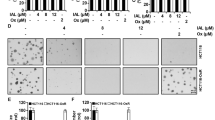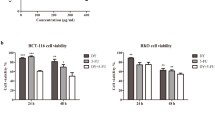Abstract
A large body of research has demonstrated a synergistic anticancer effect between docosahexaenoic acid (DHA) and standard chemotherapy regimens against colorectal cancer (CRC). In this study, we investigated the chemotherapeutic potential of cotreatment with DHA and isoliquiritigenin (ISL) against CRC HCT-116 cells. Apoptosis was confirmed by Annexin V/PI staining and expression of apoptosis-associated proteins. The synergistic effect of DHA and ISL combination on apoptosis was detected using combination index approaches. Flow cytometry was carried out using fluorescent probes to measure the production of reactive oxygen species (ROS). DHA and ISL in combination synergistically enhanced the decrease in cell viability versus the compounds used alone. Moreover, we demonstrated that the synergistic anti-CRC activity of cotreatment with these two compounds was achieved by inducing the apoptosis caspase-dependently mediated through augmented ROS generation followed by increased Fas ligand mRNA expression and cytochrome c release. Our data also demonstrated that cotreating with DHA and ISL strongly upregulated the phosphorylation of ERK and JNK, which are functionally associated with ROS induced by the two compounds in combination. Interestingly, further study revealed that inhibiting ERK phosphorylation strongly enhanced Fas ligand mRNA expression and the combination of the two compounds induced stronger cytotoxicity, whereas inhibiting JNK phosphorylation significantly reduced the apoptotic signals mediated by cotreatment with these two compounds. Excessive ROS-induced JNK activation and cytochrome c release from mitochondria played a key role in the synergistic anticancer activity of CRC cells by cotreating with DHA and ISL.






Similar content being viewed by others
Data availability
We shall make data and material available upon request.
References
Gustavsson B, Carlsson G, Machover D et al (2015) A review of the evolution of systemic chemotherapy in the management of colorectal cancer. Clin Colorectal Cancer 14:1–10
Hammond WA, Swaika A, Mody K (2016) Pharmacologic resistance in colorectal cancer: a review. Ther Adv Med Oncol 8:57–84
Van der Jeught K, Xu HC, Li YJ, Lu XB, Ji G (2018) Drug resistance and new therapies in colorectal cancer. World J Gastroenterol 24:3834–3848
Mishra J, Drummond J, Quazi SH et al (2013) Prospective of colon cancer treatments and scope for combinatorial approach to enhanced cancer cell apoptosis. Crit Rev Oncol Hematol 86:232–250
Cragg GM, Pezzuto JM (2016) Natural products as a vital source for the discovery of cancer chemotherapeutic and chemopreventive agents. Med Princ Pract 25:41–59
Fu B, Wang N, Tan HY, Li S, Cheung F, Feng Y (2018) Multi-component herbal products in the prevention and treatment of chemotherapy-associated toxicity and side effects: a review on experimental and clinical evidences. Front Pharmacol. https://doi.org/10.3389/fphar.2018.01394
Huang MY, Zhang LL, Ding J, Lu JJ (2018) Anticancer drug discovery from Chinese medicinal herbs. Chin Med. https://doi.org/10.1186/s13020-018-0192-y
Piccolo MT, Menale C, Crispi S (2015) Combined anticancer therapies: an overview of the latest applications. Anti Cancer Agents Med Chem 15:408–422
Lu DY, Lu TR, Yarla NS et al (2017) Drug combination in clinical cancer treatments. Rev Recent Clin Trials 12:202–211
Jung SK, Lee MH, Lim DY et al (2014) Isoliquiritigenin induces apoptosis and inhibits xenograft tumor growth of human lung cancer cells by targeting both wild type and L858R/T790M mutant EGFR. J Biol Chem 289:35839–35848
Wang JR, Luo YH, Piao XJ et al (2019) Mechanisms underlying isoliquiritigenin-induced apoptosis and cell cycle arrest via ROS-mediated MAPK/STAT3/NF-κB pathways in human hepatocellular carcinoma cells. Drug Dev Res 80:461–470
Jin H, Seo GS, Lee SH (2018) Isoliquiritigenin-mediated p62/SQSTM1 induction regulates apoptotic potential through attenuation of caspase-8 activation in colorectal cancer cells. Eur J Pharmacol 841:90–97
D’Eliseo D, Velotti F (2016) Omega-3 fatty acids and cancer cell cytotoxicity: implications for multi-targeted cancer therapy. J Clin Med. https://doi.org/10.3390/jcm5020015
Vasudevan A, Yu Y, Banerjee S et al (2014) Omega-3 fatty acid is a potential preventive agent for recurrent colon cancer. Cancer Prev Res 7:1138–1148
Corsetto PA, Colombo I, Kopecka J, Rizzo AM, Riganti C (2017) ω-3 Long chain polyunsaturated fatty acids as sensitizing agents and multidrug resistance revertants in cancer therapy. Int J Mol Sci. https://doi.org/10.3390/ijms18122770
Volpato M, Hull MA (2018) Omega-3 polyunsaturated fatty acids as adjuvant therapy of colorectal cancer. Cancer Metastasis Rev 37:545–555
Jiang WY, Seo GS, Kim YC, Sohn DH, Lee SH (2015) PF2405, standard fraction of Scutellaria baicalensis, ameliorates colitis in vitro and in vivo. Arch Pharm Res 38:1127–1137
Huang X, Lu Z, Lv Z et al (2013) The Fas/Fas ligand death receptor pathway contributes to phenylalanine-induced apoptosis in cortical neurons. PLoS One. https://doi.org/10.1371/journal.pone.0071553
Tummers B, Green DR (2017) Caspase-8: regulating life and death. Immunol Rev 277:76–89
Shakeri R, Kheirollahi A, Davoodi J (2017) Apaf-1: regulation and function in cell death. Biochimie 135:111–125
Li Z, Guo D, Yin X et al (2020) Zinc oxide nanoparticles induce human multiple myeloma cell death via reactive oxygen species and Cyt-C/Apaf-1/Caspase-9/Caspase-3 signaling pathway in vitro. Biomed Pharmacother 122:109712
Huang K, Zhang J et al (2016) Cleavage by Caspase 8 and mitochondrial membrane association activate the BH3-only protein Bid during TRAIL-induced apoptosis. J Biol Chem 291:11843–11851
Uchihara Y, Tago K, Taguchi H et al (2018) Taxodione induces apoptosis in BCR-ABL-positive cells through ROS generation. Biochem Pharmacol 154:357–372
Fukui M, Kang KS, Okada K, Zhu BT (2013) EPA, an omega-3 fatty acid, induces apoptosis in human pancreatic cancer cells: role of ROS accumulation, caspase-8 activation, and autophagy induction. J Cell Biochem 114:192–203
Yin Y, Sui C, Meng F, Ma P, Jiang Y (2017) The omega-3 polyunsaturated fatty acid docosahexaenoic acid inhibits proliferation and progression of non-small cell lung cancer cells through the reactive oxygen species-mediated inactivation of the PI3K/Akt pathway. Lipids Health Dis. https://doi.org/10.1186/s12944-017-0474-x
Kim DH, Park JE, Chae IG, Park G, Lee S, Chun KS (2017) Isoliquiritigenin inhibits the proliferation of human renal carcinoma Caki cells through the ROS-mediated regulation of the Jak2/STAT3 pathway. Oncol Rep 38:575–583
Chang H, Lin H, Yi L et al (2010) 3,6-Dihydroxyflavone induces apoptosis in leukemia HL-60 cell via reactive oxygen species-mediated p38 MAPK/JNK pathway. Eur J Pharmacol 648:31–38
Keshari RS, Verma A, Barthwal MK, Dikshit M (2013) Reactive oxygen species-induced activation of ERK and p38 MAPK mediates PMA-induced NETs release from human neutrophils. J Cell Biochem 114:532–540
Park M, Kim H (2017) Anti-cancer mechanism of docosahexaenoic acid in pancreatic carcinogenesis: a mini-review. J Cancer Prev 22:1–5
Merendino N, Costantini L, Manzi L, Molinari R, D’Eliseo D, Velotti F (2013) Dietary ω-3 polyunsaturated fatty acid DHA: a potential adjuvant in the treatment of cancer. Biomed Res Int. https://doi.org/10.1155/2013/310186
Jin XY, Sohn DH, Lee SH (2016) Isoliquiritigenin suppresses tumor necrosis factor-α-induced inflammation via peroxisome proliferator-activated receptor-γ in intestinal epithelial cells. Arch Pharm Res 39:1465–1471
Zhu X, Zhang K, Wang Q et al (2015) Cisplatin-mediated c-myc overexpression and cytochrome c (cyt c) release result in the up-regulation of the death receptors DR4 and DR5 and the activation of caspase 3 and caspase 9, likely responsible for the TRAIL-sensitizing effect of cisplatin. Med Oncol 32:133
Suhaili SH, Karimian H, Stellato M, Lee TH, Aguilar MI (2017) Mitochondrial outer membrane permeabilization: a focus on the role of mitochondrial membrane structural organization. Biophys Rev 9:443–457
Cagnol S, Chambard JC (2010) ERK and cell death: mechanisms of ERK-induced cell death-apoptosis, autophagy and senescence. FEBS J 277:2–21
Tanimura S, Takeda K (2017) ERK signalling as a regulator of cell motility. J Biochem 162:145–154
Dhanasekaran DN, Reddy EP (2018) JNK signaling in apoptosis. Oncogene 27:6245–6251
Song Y, Sun X, Duan F et al (2020) SYPL1 inhibits apoptosis in pancreatic ductal adenocarcinoma via suppression of ROS-induced ERK activation. Front Oncol 10:1482
Acknowledgements
This paper was supported by Wonkwang Institute of Clinical Medicine in 2016.
Author information
Authors and Affiliations
Contributions
SHL, HSK and GSS planned the research. SHL and GSS analyzed the data and prepared the manuscript. HJ conducted the experiments and analyzed the data. STY and SRS assisted experimental work.
Corresponding authors
Ethics declarations
Conflict of interest
The authors declare that they have no conflict of interest.
Additional information
Publisher’s Note
Springer Nature remains neutral with regard to jurisdictional claims in published maps and institutional affiliations.
Rights and permissions
About this article
Cite this article
Jin, H., Kim, H.S., Yu, S.T. et al. Synergistic anticancer effect of docosahexaenoic acid and isoliquiritigenin on human colorectal cancer cells through ROS-mediated regulation of the JNK and cytochrome c release. Mol Biol Rep 48, 1171–1180 (2021). https://doi.org/10.1007/s11033-021-06159-6
Received:
Accepted:
Published:
Issue Date:
DOI: https://doi.org/10.1007/s11033-021-06159-6




